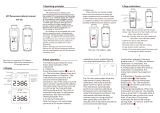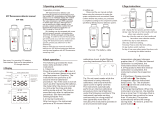Page is loading ...

(
Directions for use of
SuperSnap
Ultra- Sensitive ATP test
Part Number: ATP3000 I 100 Tests
Description and Intended Use indicate a warning that the surface is not adequately clean. If the reading
is greater than 30 the surface is considered dirty.
The SuperSnap surface sampling device is a self-contained highly
sensitive ATP (Adenosine Triphosphate) testing device for use with
Hygiena luminometers. This system is used for hygiene monitoring,
HACCP related monitoring of processing equipment, cleaning validation
and other environmental monitoring such as allergen prevention
programs. SuperSnap is designed to detect very low levels of organic
residue with greater tolerance to harsh samples that could affect the
bioluminescence reaction.
As an allergen prevention tool, SuperSnap can be used to verify the
efficacy of cleaning procedures for the removal of product residues that
may contain potential allergenic material. The enhanced sensitivity
allows detection of product residues down to 1 - 1000 ppm depending
on the product matrices. This is comparable or better than the detection
capabilities of specific allergen tests.
Overview
ATP is the universal energy molecule found in all animal, plant,
bacterial, yeast and mold cells. Product residues, particularly food
residues, contain large amounts of ATP. Microbial contamination
contains ATP, but in smaller amounts. After cleaning, all sources of
ATP should be significantly reduced. When ATP is brought into contact
with the unique liquid-stable Luciferase/ Luciferin reagent within the
SuperSnap sampling device, light is emitted in direct proportion to the
amount of ATP present. The Hygiena instrument measures the amount
of light generated and provides information on the level of contamination
within seconds.
Scigiene recommends setting RLU thresholds according to the standards
of your facility. To find out how to determine the correct threshold
settings, go to the technical solutions at w ww.scigiene.com to view
recommended practices or call one of our technical representatives.
SuperSnap is a highly sensitive test and produces more light per ATP
molecule than other Hygiena tests. Adjustments need to be made to
thresholds if UltraSnap (Part.# ATP2020) is also used on the same
Hygiena Luminometer. SuperSnap is 5 times more sensitive than
UltraSnap. Customers should adjust the thresholds 5 times higher if using
SuperSnap at locations previously tested with UltraSnap and wanting to
maintain the same level of cleanliness. Electing not to adjust thresholds
will increase the Customer's standard of cleanliness I hygiene.
Customers using SuperSnap in an allergen prevention program should
leave the threshold at the preset factory settings or adjust down
depending on the product matrices. For allergen testing technical
documents go to the resource center at www.scigiene.com.
Controls
It is recommended that calibration controls (Part No. ATP4003) be run
once a month to verify integrity of the instrument's calibration system. The
positive control should yield a result that is consistent with the signal
strength document accompanied in the positive control kit.
For more information on our positive control device go to
www.scigiene.com.
Test Procedure
1 When collecting a sample, make sure to use aseptic techniques. Do
not touch the swab or the inside of the sampling device with fingers.
Holding the swab tube, twist and pull the top of the swab out of the swab
tube. The swab tip comes pre moistened with a detergent. Condensation
may be visible on the inside of the swab tube; this is normal. Thoroughly
swab a standard 10 x 10 em (4 x 4 inches) area of interest for a typical
flat surface. Rotating the swab while swabbing a surface will increase
sample size. For irregular surfaces, ensure swabbing technique remains
consistent for each swab.
Tip: The test is designed to detect invisible amounts of product
residue. When performing sample collections, it is important to make
sure not to overload the swab bud with too much sample. Some
products in very high concentrations can inhibit the bioluminescence
reaction.
2.
After swabbing desired test area, place swab back in swab tube. The
sample can be left for up to 4 hours on the swab bud before activating
the device; however, once activated the sample must be read in
luminometer within 60 seconds.
3.
To activate the device, hold the swab tube firmly and use the thumb
and forefinger to break the Snap Valve pin by bending the bulb forward
and backward.
4.
Squeeze the bulb 5 times, expelling all liquid down the swab shaft.
Bathe the swab bud in liquid by gently shaking for 5 seconds.
5.
Insert the SuperSnap device into the Hygiena luminometer and close
the lid.
6.
Read the results by pressing "OK". Results should be read within 60
seconds after activation. Please refer to the instrument manual or web
site for operating instructions.
Interpreting Results
When using the default setting in the luminometers, readings less than 10
indicate that the surface is considered clean. Readings between 11-29
Precautions and Warnings
a.
Do not use SuperSnap device if it is already activated.
b.
Do not use devices beyond expiration date.
c.
Avoid collecting large amounts of sample on swab bud.
d.
Hold the instrument upright when taking readings.
e.
Hold SuperSnap device upright when activating.
f.
SuperSnap sampling device should be read within 60 seconds after
activation.
g.
Keep SuperSnap out of direct sunlight.
h.
Users must establish and validate threshold limits for their application.
Storage and Shelf Life
•
SuperSnap sampling devices must be refrigerated at 2-8°C (35- 46°F).
•
Sample devices should be left out at room temperature for 10 minutes
before being used.
•
Sample devices will tolerate temperature abuse for 4-weeks at room
temperature (<25°C).
•
SuperSnap devices have a shelf life of 15 months.
Safety
The components of SuperSnap do not pose any risk to health when used
in accordance with the procedures of this insert. For further safety
instructions refer to product MSDS.
More Information
If more information is required, please visit us at www.scigiene.com
or contact us at:
/





